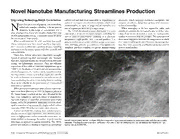
NASA Technical Reports Server (NTRS) 20080003910: Novel Nanotube Manufacturing Streamlines Production PDF
Preview NASA Technical Reports Server (NTRS) 20080003910: Novel Nanotube Manufacturing Streamlines Production
Novel Nanotube Manufacturing Streamlines Production Originating Technology/NASA Contribution carbon rod and then form nanotubes by depositing the processes, which required expensive equipment like vapor onto a water-cooled carbon cathode, which then vacuum chambers, dangerous gasses, and extensive Nanotubes are sheets of graphite, one atom thick, yields bundles, or ropes, of single-walled nanotubes at a technical knowledge. rolled into seamless cylinders, with an exterior rate of 2 grams per hour using a single setup. While managing to be less expensive, safer, and diameter in the range of nanometers. For a The NASA-developed process eliminates the costs simpler, the process also increases the quality of the nano- sense of perspective, if you were to split a human hair into associated with the use of metal catalysts, including the tubes. Since no metal catalyst is used, no metal particles 50,000 independent strands, a nanotube would be about cost of product purification, resulting in a relatively need to be removed from the product. The elimination of the size of one of those strands. inexpensive, high-quality, very pure end product. The these metal impurities increases the temperature at which What would someone do with anything that small? process employs an arc welder, a helium purge, an ice water the materials will degrade and eliminates any damage that These nanostructures have novel qualities that make bath, and basic processing experience. This significantly may have been caused by purification processes used to them uniquely qualified for a plethora of uses, including simplifies previous complex, dangerous manufacturing remove metal residue. applications in electronics, optics, and other scientific and industrial fields. These thin, hollow tubes have remarkable strength, especially considering their microscopic size. Stronger than steel, nanotube strands can be used to form extremely strong, yet lightweight, materials. They are efficient conductors of heat (able to withstand temperatures up to 2,000 °C in the absence of oxygen) and also possess unique electrical properties. Nanotubes can be manufactured so that they conduct electricity as well as copper, but can also be made to function as semiconductors (able to switch from conducting electricity to insulating from it), making them quite valuable in the production of miniaturized electronic components. Although scientists have been aware of these nanostruc- tures since their discovery in 1991 by Japanese physicist Dr. Sumio Iijima, practical use has been thwarted by the high costs, complexity, and even danger of manufactur- ing them. A group of researchers at Goddard Space Flight Center, led by Dr. Jeannette B. Benavides, however, devel- oped a manufacturing process for single-walled carbon nanotubes (SWCNTs) that overcomes these obstacles. Typical methods for creating these nanostructures, whether chemical vapor deposition, laser ablation, micro- wave, or high-pressure carbon monoxide conversion, use metal catalysts to encourage the carbon to grow into the NASA’s single-walled carbon nanotube (SWCNT) manufacturing process eliminates the costs associated with the use of metal tube shape, as opposed to capping and sealing. The NASA catalysts, including the cost of product purification. As a result, the manufacturing cost can be reduced significantly for high- process uses helium arc welding to vaporize an amorphous quality, very pure SWCNTs. 118 Industrial Productivity and Manufacturing Technology Spinoff 2007 Partnership In 2003, Benavides filed a New Technology Report at Goddard, bringing her invention to the attention of the Center’s Innovative Partnerships Program (IPP) office, which acknowledged the role this production process could play in making carbon nanotubes more accessible. The IPP office started the process of finding commercial partners. To get this cutting-edge process into the hands of the public, Goddard’s IPP office promoted the technology in print, online, and at industry conferences. In 2005, the technology captured the interest of Wayne Whitt, an entrepreneur interested in forming an advanced materials corporation, but who was in search of an innovation that would help his company stand out from the crowd. Shortly after learning about the SWCNT manufacturing technology, Whitt applied for a nonexclusive license and formed the Boise-based Idaho Space Materials Inc. (ISM). Product Outcome Once the license was granted, ISM then worked with Benavides and the University of Idaho’s Electron Microscopy Center to examine and improve upon vari- ables in the manufacturing process, ultimately enhancing the process by increasing yield and production capacity. Once the process was tweaked, ISM was ready to com- mercialize its products, and the inexpensive, robust nanotubes are now in the hands of the scientists who Unlike most current methods—which require expensive equipment (e.g., vacuum chamber), dangerous gasses, and extensive will create the next generation of composite polymers, technical knowledge to operate—NASA’s simple SWCNT manufacturing process needs only an arc welder, a helium purge, an ice water bath, and basic processing experience. metals, and ceramics that will impact the way we live. In fact, researchers are examining ways for these newfound In August 2006, ISM unveiled its new line of single- Agency’s patented technology will produce revenue that materials to be used in the manufacture of transistors and walled nanotubes with no metal catalyst under the name NASA can reinvest in additional research, and it now has fuel cells, large screen televisions, ultra-sensitive sensors, NOMEC 1556. The advanced materials company has a reliable source from which to obtain high-quality, low- high-resolution atomic force microscopy probes, super- had tremendous success with its new product, and has cost SWCNTs for use in its research and missions. v capacitors, transparent conducting films, drug carriers, nearly tripled in size. catalysts, and advanced composite materials, to name just The transfer of this NASA technology has also been a few. beneficial to NASA, as widespread use of the Space Spinoff 2007 Industrial Productivity and Manufacturing Technology 119
